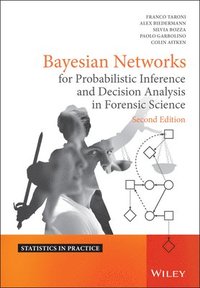
- Format
- Inbunden (Hardback)
- Språk
- Engelska
- Antal sidor
- 480
- Utgivningsdatum
- 2014-09-05
- Upplaga
- 2 ed
- Förlag
- John Wiley & Sons Inc
- Illustrationer
- black & white illustrations, black & white tables, figures
- Dimensioner
- 244 x 173 x 28 mm
- Vikt
- Antal komponenter
- 1
- ISBN
- 9780470979730
- 863 g
Bayesian Networks for Probabilistic Inference and Decision Analysis in Forensic Science
- Skickas från oss inom 5-8 vardagar.
- Fri frakt över 249 kr för privatkunder i Sverige.
Passar bra ihop
De som köpt den här boken har ofta också köpt Who's Afraid of Gender? av Judith Butler (inbunden).
Köp båda 2 för 1393 krKundrecensioner
Fler böcker av författarna
-
Data Analysis in Forensic Science
Franco Taroni, Silvia Bozza, Alex Biedermann, Paolo Garbolino, Colin Aitken
-
Statistical Analysis in Forensic Science
Grzegorz Zadora, Agnieszka Martyna, Daniel Ramos, Colin Aitken
-
Statistics and the Evaluation of Evidence for Forensic Scientists
Colin Aitken, Franco Taroni
-
Bayes Factors for Forensic Decision Analyses with R
Silvia Bozza, Franco Taroni, Alex Biedermann
Recensioner i media
"The clear and accessible style of this second edition makes this book ideal for all forensic scientists, applied statisticians and graduate students wishing to evaluate forensic findings from the perspective of probability and decision analysis. It will also appeal to lawyers and other scientists and professionals interested in the evaluation and interpretation of forensic findings, including decision making based on scientific information." (Zentralblatt MATH, 1 October 2014)
Övrig information
FRANCO TARONI, University of Lausanne, Switzerland ALEX BIEDERMANN, University of Lausanne, Switzerland SILVIA BOZZA, University Ca' Foscari of Venice, Italy PAOLO GARBOLINO, University IUAV of Venice, Italy COLIN AITKEN, University ofEdinburgh, UK
Innehållsförteckning
Foreword xiii Preface to the second edition xvii Preface to the first edition xxi 1 The logic of decision 1 1.1 Uncertainty and probability 1 1.1.1 Probability is not about numbers, it is about coherent reasoning under uncertainty 1 1.1.2 The first two laws of probability 2 1.1.3 Relevance and independence 3 1.1.4 The third law of probability 5 1.1.5 Extension of the conversation 6 1.1.6 Bayes' theorem 6 1.1.7 Probability trees 7 1.1.8 Likelihood and probability 9 1.1.9 The calculus of (probable) truths 10 1.2 Reasoning under uncertainty 12 1.2.1 The Hound of the Baskervilles 12 1.2.2 Combination of background information and evidence 13 1.2.3 The odds form of Bayes' theorem 15 1.2.4 Combination of evidence 16 1.2.5 Reasoning with total evidence 16 1.2.6 Reasoning with uncertain evidence 18 1.3 Population proportions, probabilities and induction 19 1.3.1 The statistical syllogism 19 1.3.2 Expectations and population proportions 21 1.3.3 Probabilistic explanations 22 1.3.4 Abduction and inference to the best explanation 25 1.3.5 Induction the Bayesian way 26 1.4 Decision making under uncertainty 28 1.4.1 Bookmakers in the Courtrooms? 28 1.4.2 Utility theory 29 1.4.3 The rule of maximizing expected utility 33 1.4.4 The loss function 34 1.4.5 Decision trees 35 1.4.6 The expected value of information 38 1.5 Further readings 42 2 The logic of Bayesian networks and influence diagrams 45 2.1 Reasoning with graphical models 45 2.1.1 Beyond detective stories 45 2.1.2 Bayesian networks 46 2.1.3 A graphical model for relevance 48 2.1.4 Conditional independence 50 2.1.5 Graphical models for conditional independence: d-separation 51 2.1.6 A decision rule for conditional independence 53 2.1.7 Networks for evidential reasoning 53 2.1.8 The Markov property 56 2.1.9 Influence diagrams 58 2.1.10 Conditional independence in influence diagrams 60 2.1.11 Relevance and causality 61 2.1.12 The Hound of the Baskervilles revisited 63 2.2 Reasoning with Bayesian networks and influence diagrams 65 2.2.1 Divide and conquer 66 2.2.2 From directed to triangulated graphs 67 2.2.3 From triangulated graphs to junction trees 69 2.2.4 Solving influence diagrams 71 2.2.5 Object-oriented Bayesian networks 74 2.2.6 Solving object-oriented Bayesian networks 79 2.3 Further readings 82 2.3.1 General 82 2.3.2 Bayesian networks and their predecessors in judicial contexts 83 3 Evaluation of scientific findings in forensic science 85 3.1 Introduction 85 3.2 The value of scientific findings 86 3.3 Principles of forensic evaluation and relevant propositions 90 3.3.1 Source level propositions 92 3.3.2 Activity level propositions 94 3.3.3 Crime level propositions 97 3.4 Pre-assessment of the case 100 3.5 Evaluation using graphical models 103 3.5.1 Introduction 103 3.5.2 General aspects of the construction of Bayesian networks 103 3.5.3 Eliciting structural relationships 105 3.5.4 Level of detail of variables and quantification of influences 106 3.5.5 Deriving an alternative network structure 108 4 Evaluation given source level propositions 113 4.1 General considerations 113 4.2 Standard statistical distributions 115 4.3 Two stains, no putative source 117 4.3.1 Likelihood ratio for source inference when no putative source is available 117 4.3.2 Bayesian network for a two-trace case with no putative source 119 4.3.3 An alternative network structure for a two trace no putative source case 121 4.4 Multiple propositions 122 4.4.1 Form of the likelihood ratio 122 4.4.2 Bayesian networks for evaluation given multiple propositions 123 5 Evaluation given activity level propositions 129 5.1 Evaluation of transfer material given activity level propositions assuming a direct source relationship 130 5.1.1 Preliminaries 130 5.1.2 Derivation of a basic structure for a Bayesian network 131 5.1.3 Modifying the basic netw
Du kanske gillar
-
Bad Therapy
Abigail Shrier
Inbunden


